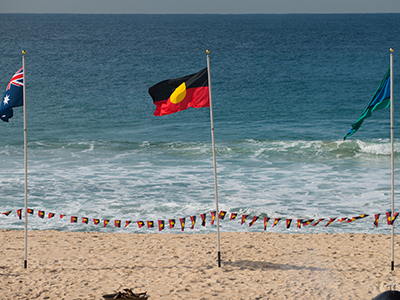Coogee and the Bidjigal and Gadigal People
- Published Date
- 21/05/2019
- News Topic
- Workshops, Seminars & Classes

As most locals already know, the name Coogee is derived from a local Aboriginal word. The word, ‘koojay’, ‘koojah’ or ‘koo-chai’ or ‘koo-jah’, can also mean the ‘smell of seaweed drying’, referring to the drying out of kelp or seaweed, which sometimes can still wash up on the shores of Coogee Beach and leave bit of a distinctive smell.
Coogee is a word from the Dharug language, which was spoken by the people of the Eora nation, who inhabited the current Sydney metropolitan basin. Within this nation there were many different Bands (or clan groups), the Bidjigal and Gadigal people lived in and around the Coogee area.
The Bidjigal and Gadigal people were coastal dwelling clans and they were dependent on the harbour and ocean for providing food. Their main source of food was fish, with men using spears and women using hooks and lines to catch it. Both fished from canoes made of bark and the women also gathered shellfish and plant food such as native figs or fern roots.
At the time of European settlement, there were many Aboriginal people living in Coogee. Although numbers aren’t easy to come across, some sources site an estimated 1500 Aboriginal people lived between Broken Bay, Wreck Bay and Botany Bay.
Yet as we know, contact between the Europeans and Aboriginals was devastating for Aboriginal people. Diseases such as smallpox wiped out many Aboriginal people, as did massacres and fighting, as European government policies pushed for Australia to be colonised and edged Aboriginal people off their land.
One of the most well-known Gadigal people is Patyegarang, a young woman who shared the Gadigal language with Lieutenant William Dawes, the European colony’s timekeeper. Dawes kept journals of the time he spent with Patyegarang and noted the words and expressions he was taught by her in a journal.
The books recorded Patyegarang’s visits with Dawes and showed their increasingly familiar and intimate conversations. The notebooks show Dawes and Patyegarang had a mutual respect for each other and shared humour and deep conversation.
To celebrate and remember our Aboriginal heritage and the country’s original inhabitants, each year we hold the Koojay Corrobboree as part of National Reconciliation Week, where the sands of Coogee Beach come alive with traditional dance and ceremony.
